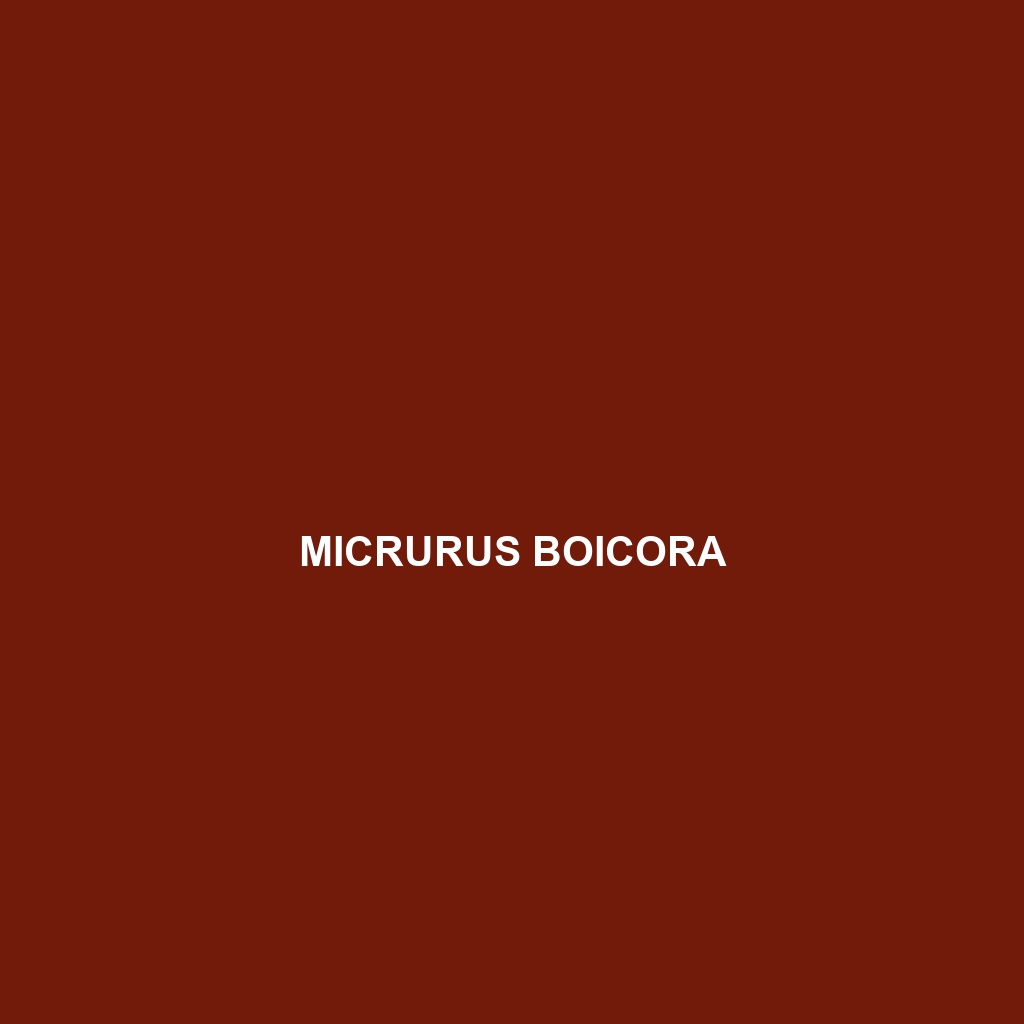Common Name
Micrurus boicora
Scientific Name
Micrurus boicora
Habitat
Micrurus boicora, commonly known as the Boicora Coral Snake, primarily inhabits tropical and subtropical environments across parts of South America. This species is found in regions such as the Amazon rainforest, the Brazilian savannas, and areas adjacent to temperate forests. The preferred habitats of Micrurus boicora include dense vegetation, leaf litter, and humid microclimates that provide adequate shelter and moisture crucial for their survival. Additionally, these snakes are often associated with edaphic (soil-related) environments, showcasing their adaptability to various ecological niches within their geographic range, which includes regions of Brazil and Paraguay.
Physical Characteristics
The Boicora Coral Snake is easily identifiable due to its striking coloration and unique anatomical features. Adults typically reach lengths of 60 to 90 centimeters, with some exceptional specimens noted at over a meter. The body is slender and elongated, adorned with vivid bands which can range in color from bright red and yellow to deep black. The arrangement of these bands often serves as a warning to potential predators, acting as a deterrent to attacks. One distinctive feature of Micrurus boicora is its small, rounded head, which is not clearly delineated from the neck, a characteristic trait of several species within the Eunectes genus. Furthermore, like other coral snakes, it possesses a potent neurotoxic venom that is primarily used for subduing prey.
Behavior
Micrurus boicora exhibits primarily nocturnal behavior, demonstrating activity patterns that align with low-light environments, especially during the rainy season. During the day, these snakes are often found hiding under debris or leaf litter, which provides camouflage against predators. Their social interactions are generally solitary, with individuals rarely engaging in cooperative behaviors. Mating rituals typically occur during the warmer months, showcasing intricate courtship behaviors where males may engage in combat for mating rights. Interestingly, these snakes are also known to exhibit defensive behaviors by displaying their vivid coloration when threatened, a behavior that serves both to intimidate potential attackers and to warn them of their venomous nature.
Diet
Micrurus boicora is predominantly a carnivore, with a diet that primarily consists of small reptiles and amphibians, including frogs and lizards. Evidence suggests that they play a crucial role in controlling the populations of these species within their habitat. As active foragers, Micrurus boicora employs precise strikes to capture its prey, utilizing its potent venom to immobilize them quickly. Their prey-specific feeding patterns and hunting strategies highlight their importance within the food web, where they serve as both predator and prey in the ecosystem.
Reproduction
The reproductive cycle of Micrurus boicora typically occurs during the rainy season when environmental conditions favor mating and subsequent offspring survival. The gestation period is estimated to last approximately 60 to 70 days, after which the female lays between 5 to 12 eggs, depending on individual health and habitat conditions. Hatchlings are born highly venomous and independent, capable of fending for themselves immediately. Parental care is minimal, with the female departing soon after laying eggs, emphasizing the necessity for the hatchlings to quickly adapt to their environment for survival. The development of hatchlings occurs in the same habitat, where they remain hidden until they reach maturity.
Conservation Status
Currently, Micrurus boicora is classified as Least Concern by the International Union for Conservation of Nature (IUCN). This status indicates that, while not currently threatened, the species may face challenges due to habitat loss caused by deforestation and urbanization. Conservation efforts are essential for preserving its natural habitats, sustaining populations, and ensuring genetic diversity within their ecosystems. Monitoring programs focusing on habitat preservation and educating local communities about the ecological role of these snakes are crucial for their long-term viability.
Interesting Facts
One particularly interesting aspect of Micrurus boicora is its cryptic behavior and adaptive coloration that allows it to blend seamlessly into its rainforest surroundings, making it challenging for potential predators to find them. Furthermore, their venom is unique among snakes, containing a cocktail of neurotoxins that effectively interferes with the nervous system of their prey. Although coral snakes are often feared, they are crucial to maintaining the balance within their ecosystems and hold significant ecological value as both predator and prey.
Role in Ecosystem
The ecological role of Micrurus boicora extends beyond its predatory behaviors. As a predator, it helps maintain population control of small reptiles and amphibians, thus contributing to the overall health of the ecosystem. Additionally, by serving as prey for larger animals, it provides necessary nutrients within the food web. Its presence indicates a healthy biodiversity within its habitat, and it plays a part in the intricate balance of local ecosystems, exemplifying the importance of all species in environmental stability.
